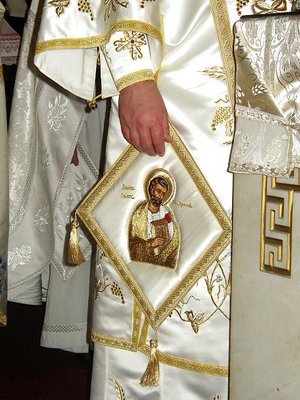The epigonation (Greek: ἐπιγονάτιον, literally meaning "over the knee"), or palitza (Russian: палица, "club"), is a diamond-shaped vestment worn on the right side by priests and bishops.
In the Byzantine tradition, the epigonation is awarded to a priest upon his elevation to exomologos (confessor) or the rank of οικονόμος. In the Russian tradition, it is an award given after many years of service.
It represents a shield, originating from the thigh shield worn by soldiers during the days of the early church. The epigonation holds a dual meaning. First, it denotes the celebrant as a "soldier" of Christ. Second, it symbolizes the Word of God, fighting the wiles of the enemy.
Description and usage
The epigonation is worn by all bishops, and as an ecclesiastical award for some priests.[1] Its origin is traced to the practice of Byzantine Emperors awarding ceremonial swords to their military commanders in recognition of their valour in defending the empire. Such swords were often accompanied by elaborate thigh-shields which were suspended from the belt and protected the leg from bruising caused by the constant bumping of the sword against the thigh. When the emperors began to give awards to the clergy, the thigh-shield alone was awarded.Cite error: Closing </ref> missing for <ref> tag Also, in some liturgical traditions, when a bishop performs a lesser ordination, such as the setting-apart of a subdeacon, he lays his epigonation over the candidate's head as he says the prayer.
Notes
- ↑ Hapgood, Isabel F. (1922), Service Book of the Holy Orthodox-Catholic Apostolic Church (5th ed.), Englewood, NJ: Antiochian Orthodox Christian Archdiocese (published 1975), pp. xxxviii
